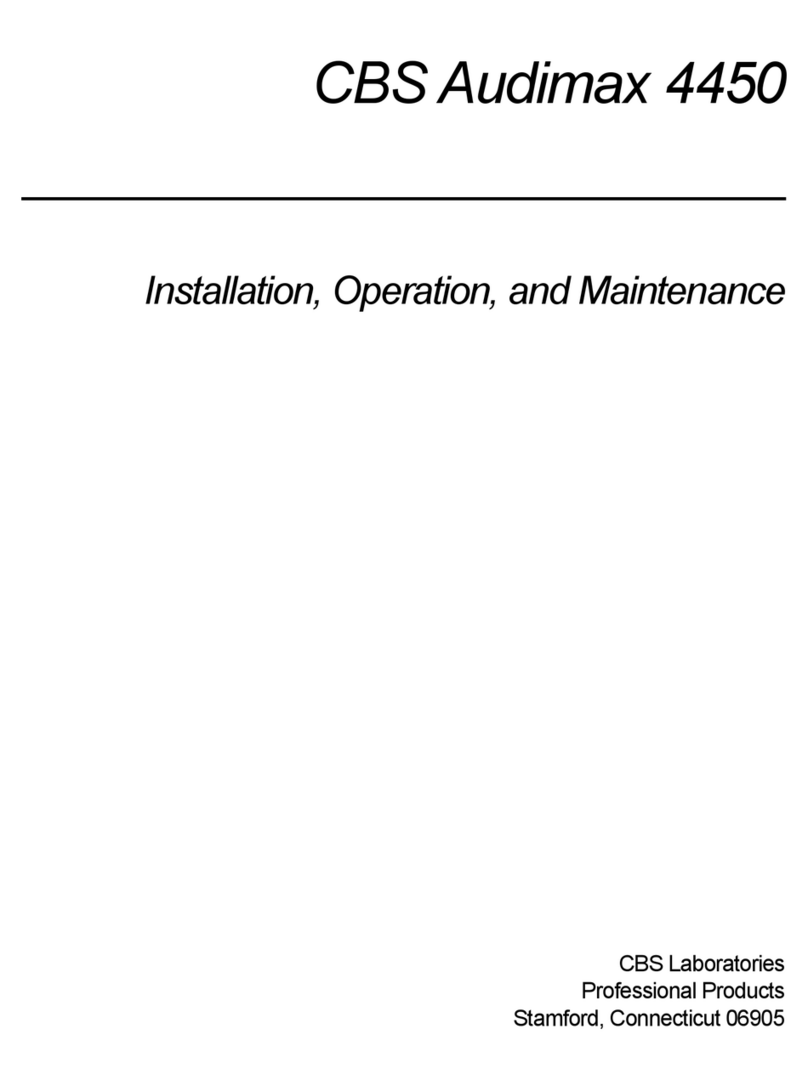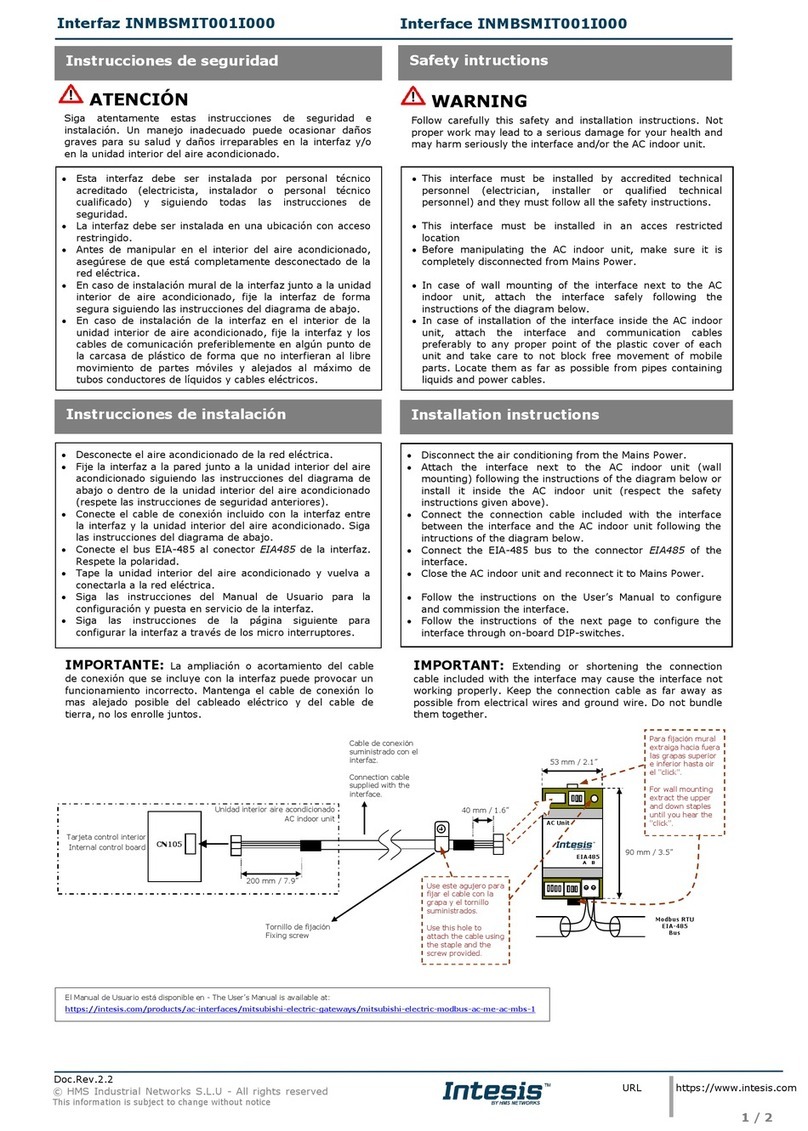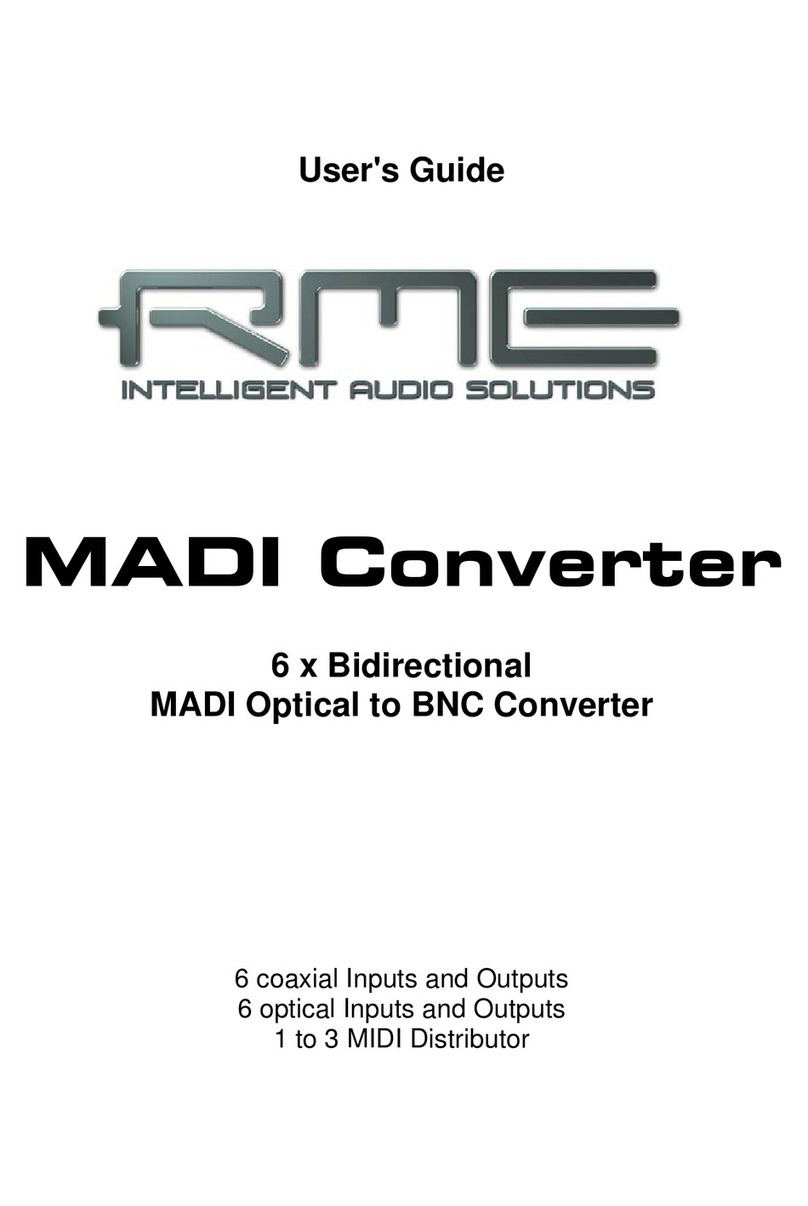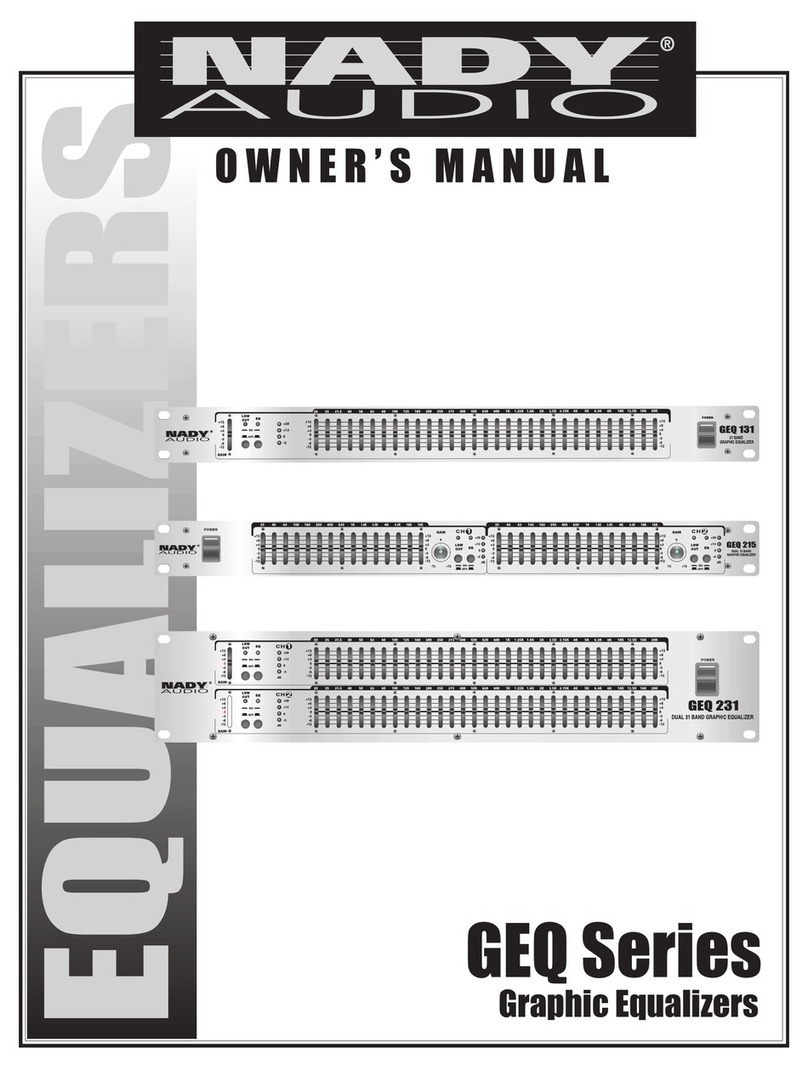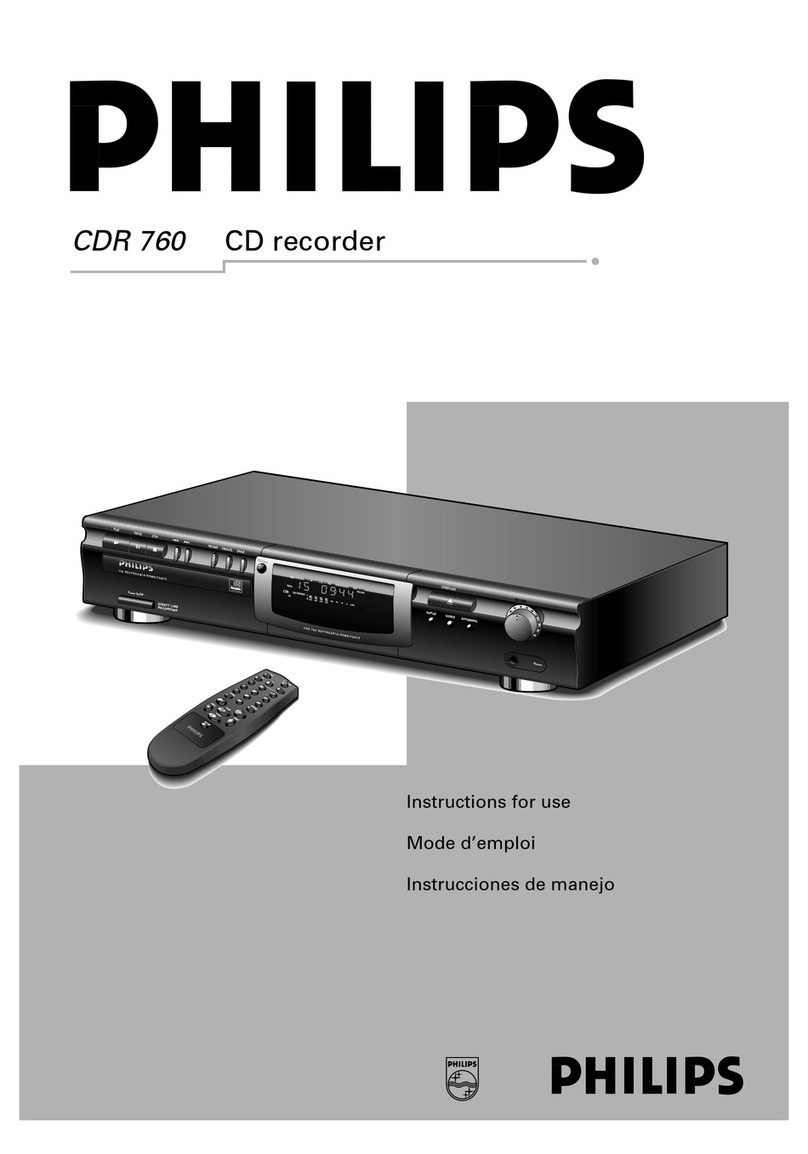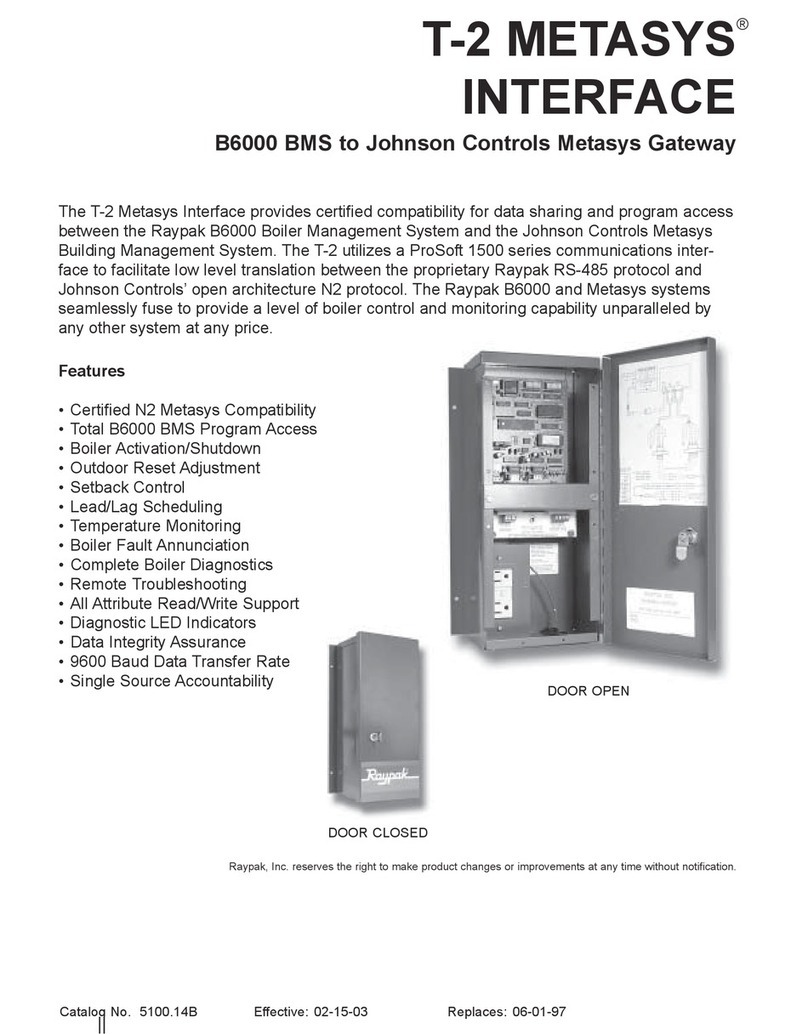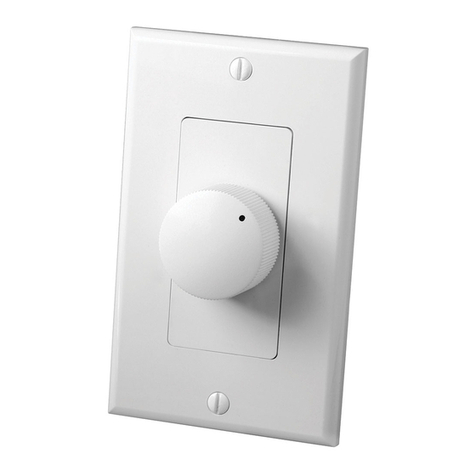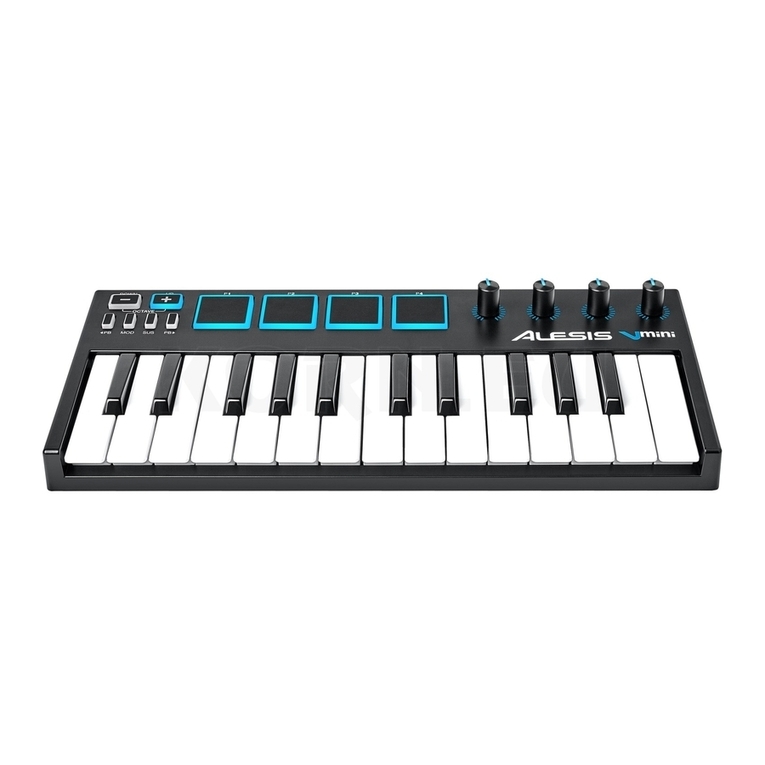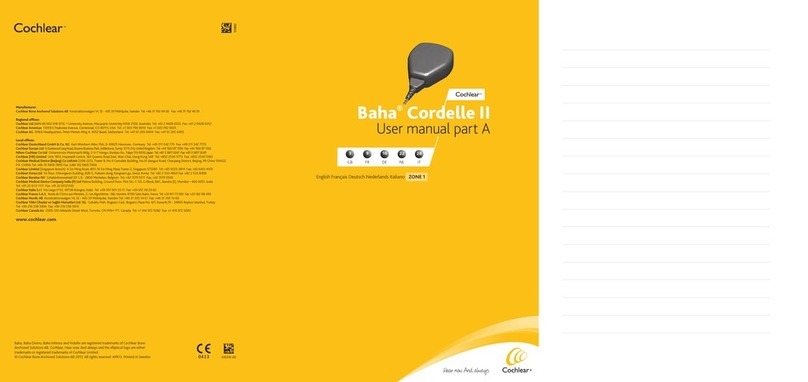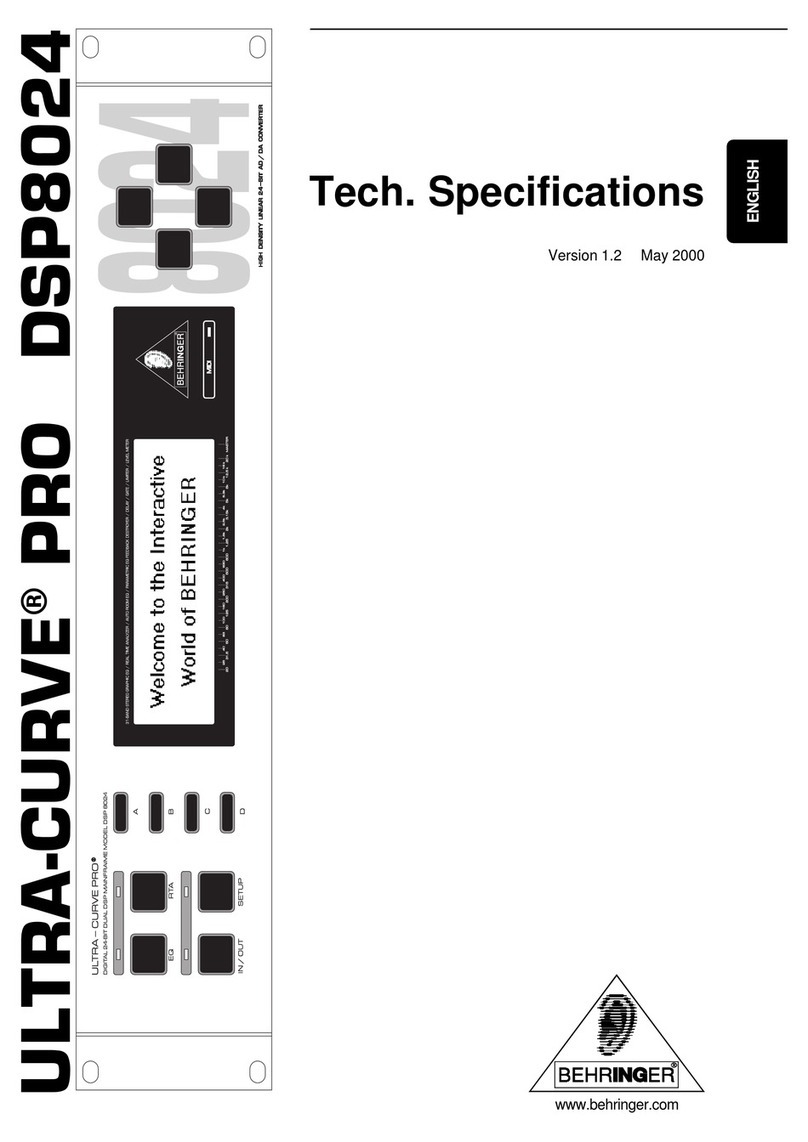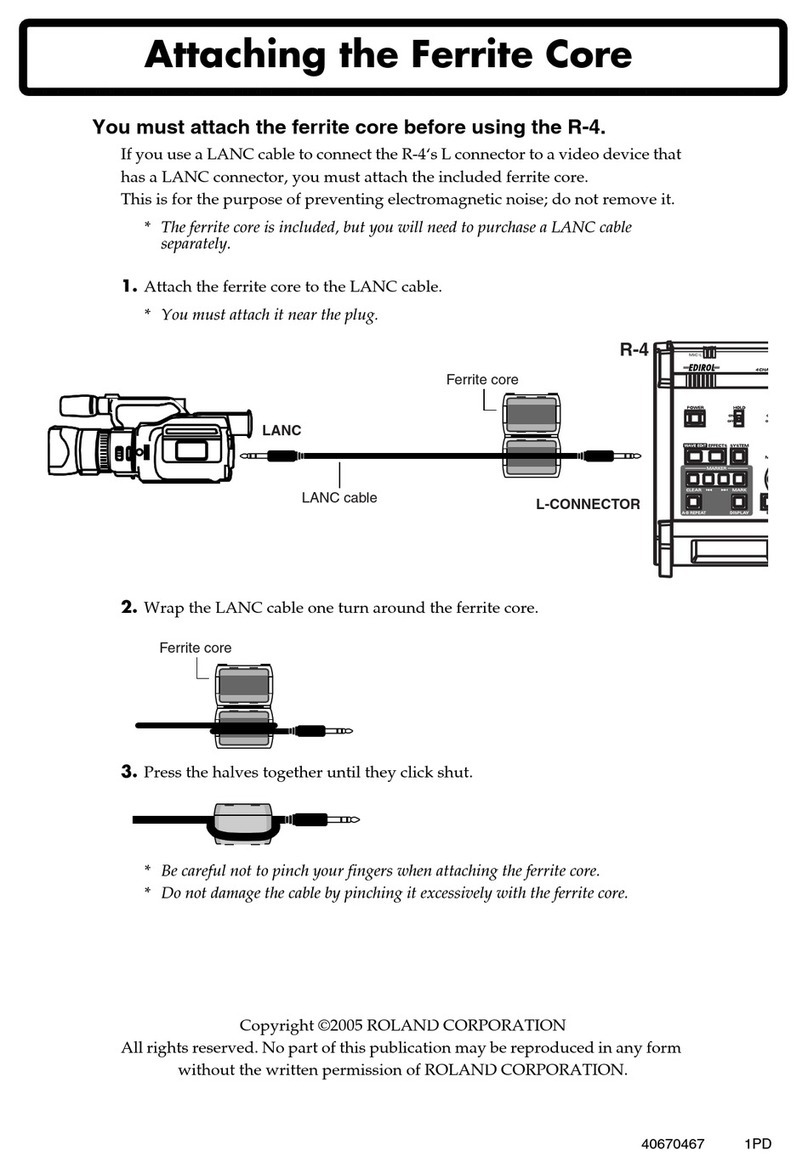CBS laboratories FM Volumax 410 Manual

www.SteamPoweredRadio.Com
~
LABORATORIES
TABLE
OF
CO
NTENTS
SECTION I - lNTRODUCTlON
~eNo.
l-1
General
1-1
1-2
Warranty
1-1
1-3
Factory
Servi
ce
and
Repair
1-2
1-4
Specifications
1-2
SECTION
ll
-INSTALLATION INSTRUCTIONS
2-1
Unpacking
2-1
2-2
Power
Supply 2-1
2-3
Installation
2-2
2-
4
Electrical
Connectio
ns 2-3
SECTION
ID
-
SET-IJP
PROCEDURES
3-1
Gene
ral
3-1
3-2
Stereophonic
Operation
3-2
3-3
Pr
c,of
or
Performance
Measurements
3-4
SECTION IV -PRINCI
PLES
OF
OPERATION
4-1
General
4-1
4-2
Circuit
Operati
on
4-2
SECTION V - MAINTENANCE
5-1
Electrical
Alignment
5-1
5-2
Troubleshooting
5-2
5-3
Transient
Characteristics
5-4
5-4
50
Microsecond
Operallon
5-5
SECTION VJ -
PARTS
LIST
6-1 Input
Board
Assembly
6-1
6-2
Power
Supply
Board
6-1
6-3
output
Board
Assembly
6-2
6-4
AGC Board
Assembly
*I
6-2
6-5
AGC Board
Ass
emb
ly
# 2
6-3
6-6
Control
Board 6-3
6-7
Miscellan
eous
Parts
6-4
Revised
May,
1967

www.SteamPoweredRadio.Com
~
LABORATORIES
LIST
OF
ILLUSTRATIONS
Figur
e 1-1
The
FM
Voluma.x
Automatic
Peak
Controller
1-1
Figure
2-1
Circuit
Board
Layout
2-1
Figure
2- 2
600
ohm,
16
dB
Attenuation
Network
2-2
Figure
4-1
FM
Voluma.x
Amplitude
R
esponse
4-3
Figw·
e
4-2
FM
Volumax Block
Diagram
4-4
Figure
5-1
FM
Voluma.x Sc
hematic
Diagram
5-6
ii

www.SteamPoweredRadio.Com
1-1 GENERAL
SECTION I
INTRODUCTION
~
LABORATORIES
This
instruction
book co
nt
ains
complete
maintenance
and
operating
instructions
for
the
Model
410
and
Model
411
(Stereo)
FM
Volumax.
The
i
nstrum
ent
has
been
designed
for
the
FM
and
TV
broadcaster
and
will
enable
him
to
use
his
full
modulation
capability
with
no
risk
of
overmodu
-
lation
or
distortion.
Used
with
SCA
systems,
it
prevents
crosstalk
caused
by
overmodulation
into
adjacent
channels.
It
replaces
any
li
miter
or
c
lipper
that
may
now
be
in
use
and
should
be
used
with
well-controlled
input
levels
such
as
those
provided
by
the
CBS L
aboratories'
Audimax
automatic
level
control.
The
various
problems
associated
with
FM
and
TV
broadcasting
and
their
solutions
are
dis-
cussed
at
length
in
Section
IV of
this
book.
Figure
1-1
The
FM
Volumax
Automatic
Peak
Contro
ll
er
l-2
WARRANTY
A
standard
warranty
card
with
a
return
post
card
has
been
included
with
your
FM
Volumax.
Fill
out
the
card
and
return
it
to
CBS
Laboratories
as
soon
as
possible
in o
rd
er
to
validat
e
your
warranty.
Your
new FM Volumax
is
warranted
ag
ainst
elect
r
ical
a
nd
mechanical
defects
for
a
period
of
one
year
after
you
register
th
e
warranty.
Refer
to
th
e
warranty
card
for
th
e
specifics
on
our
resp
o
nsibilities
and
yours.
1-1

www.SteamPoweredRadio.Com
~LAB
O
RAT
O
RI
E S
l-3
FACTORY SERVICE
AND
REPAIR
If you should
exper
ience
difficulty
in
installing
or
operating
the
FM
Volumax,
please
contact
the
Professional
Products
De
partment
at
CBS
Laboratories
in
Stamford,
Conn. Within the
continental
limits
of the United
States,
ca
ll
collect
area
code {203) 327-2000.
1-4 SPECIFICATIONS
Dimensions:
Fits
standard
19-inch
rack,
3-1/2"
high
and
9-5/8"
deep
.
Frequency
R
esponse:
Below
threshold
of
limiting:
Flat
within 1 dB, 50 H
z*
to
1
5,000
Hz.
Above
threshold:
Variable
depending on
level.
Al
maximum
level,
response
follows
75-microsecond
de-emphasis
cu
rv
e within 1 dB.
Harmon
ic
Dist
ortion:
Less
than
1%
from
50 to
15
,000 Hz
thro
ughout
entire
control
range.
Input Level: -24
to
+8
dBm
Maximum
Peak
Output L
evel:
+2
1dBm
Input
and
Output Impedance: 600
ohms
balan
ce
d
or
unbalanced (
150
ohms
available
on
request)
.
Noise
Level: Below -70
dB
re
+
21
dBm output
Maximum Gain: 50
dB
Attack
Tim
e:
Less
than l
microsecond
or
2
millisecon
ds depending on
program
waveform
Recovery
Time:
Low
Frequency
Loop:
140
milliseconds
High
Frequency
Loop:
10
milliseconds
Maximum
Operating
Temperature:
55°
C
Power
Required:
15
watts
at
115-230 V AC, 50/60 Hz.
* Hz,
abbreviation
for
Hert
z,
has been adopted
as
the new engin
eering
term
for
cycles
per
second.
KHz
is
1000
cps.
1-2

www.SteamPoweredRadio.Com
2-1 UNPACKING
SECTION
II
INSTALLATION INSTRUCTIONS
~
LABORATORIES
Examine
your
FM
Volumax
carefully
for
evidence
of
possible
shipping
damage.
If
the
equip-
ment
is
damag
e
d,
file
a c
laim
with
the
carrier
and
notify
us
immediately.
If
future
trans-
portation
of
the
instrum
e
nt
is
anticipated,
save
the
shipping
carton
and
the
packing
material.
2-2
POWER
SUPPLY
( See
Figure
2-1)
The
transformer
in
the
power
supply
of
the
FM
Volumax
allows
the
selection
of
either
115
or
230
volt
operation.
The
unit
is
shipped
for
115
volt
operation.
If
230 v
olt
operation
is
re
-
quired
,
remove
the
jumpers
on
the
power
supply
board
between
lugs
1
to
2
and
3 to
4.
Re-
connect a
sing
le
jumper
between
lugs
2
and
3.
Repla
ce
the
fuse
with
a type 3AG
rated
0.10 Amp.
R222
--
--,
Output
Board
AGC
Board
#2
AGC
Board
#1 I
Control
Board
Power
Supply Bao
rd
Figure
2-1
Circuit
Board
Layout
2-1

www.SteamPoweredRadio.Com
~
LABOflATOfllES
2-3 INSTALLATION
FM
Volumax
is
designed
to
be
mounted
in
a
standard
19"-wide
rack.
It
requires
3-1/2"
panel
space
and
is
slightly
less
than
10"
deep.
As with
all
transistorized
equipment,
the
unit
must
be
installed
in
a
reasonably
well-ventilated
position,
with
no
high
heat-producin
g equipment
benea
th
it.
NOTE:
Ambient
temperatur
e
should
not
exceed
130° F.
FM
Volumax
is
normally
installed
at
the
transmitter,
immediately
preceding
the
transmitter
audio input
terminals.
H
owever,
it
may
be
installed
at
the
studio
ahead
of
the
program
line
to
the
transmitter,
when
the
phase-amplitude
characteristic
between
studio
and
transmitt
er
are
known
to
be
uniform
under
all
climatic
conditions
and
telephone company equipment
changes.
For
o
ptimum
operation,
the
FM
Volumax shou
ld
be
fed
uniform
average
program
levels
and
--
as
in
the
c
as
e with
all
limit
ers
--
shou
ld
not
be
used
to
perform
a
gain-ri
ding function.
The
use
of
CBS
Laboratories'
Audimax
is
r
ec
ommended
wit
h
the
FM
Vo
lum
ax. Any wave
shaping
or
phase
scramblin
g
devices
shou
ld
be
used
ahead
of
the
instrument.
The
FM
Voluma.x
has
sufficient
gain
to
correct
for
the
long-line
and
equal
izer
l
osses
incurred
when
the
transmitter
site
is
remotely
loca
t
ed,
and
input
l
evels
as
low
as
-24
dBm
can
be
tol
erated.
Howev
er,
if input
levels
excee
din
g
+8
dB
m
are
used,
the
range
of
attenuation
on
the
input pad
will
not be
sufficient.
Such
is
the
case
when a CBS
Labor
at
ories'
tube-type
Audimax
is
connected
directly
to
the
FM
Volumax input.
If a CBS
Laborator
i
es'
M
odel
440,
441
or
443 Audi
max
is
used
to
feed
the
FM
Volumax, the
atte
nuator
circuit
shown
in
Figure
2-2
must
be
inserted
in
the
line
betw
ee
n
the
units.
An
atte
n
uator
is
not
necessary
wh
en
using
the
Model 444
Audimax
m.
~""----~---M/IMIVW.W--
--
430 n 430 n
200n
Figure
2-2
600 o
hm
,
16
dB
Attenua
ti
on Network
2-2

www.SteamPoweredRadio.Com
~
LABORATORIE
9
The
standard
FM
Volumax
is
designed
to
work
in
conju
ncti
on
with a 75-
microsecond
trans-
mitter
pre-emphasis
network.
H
owever,
if
operation
into a
50-mi
cr
oseco
nd netw
ork
is
re-
qu
ired,
such
as
th
e CC
IR
standard,
modify the
instrum
ent
as
outlined in Section V of
this
manual.
F
or
ste
reophonic
transm
ission,
th
e Model
411
FM
Volumax
is
used.
Thi
s
instrument
co
ns
ists
of two Mod
el
410
FM
V
ol
umax
co
upled
mechanically
and
elect
r
ically
in
a
single
fram
e.
For
field
conversion
of a
monaural
FM
Vo
lu
max
Mo
del
410
to
stereo,
o
rder
a
second
Mod
el
41
0 and
a Stereophonic Cable
Assembly
# 200354
directly
from
CBS Lab
oratories.
Connect the two
units with the
ca
bl
e
assemb
ly
and
adjust
R227 on both
unit
s
so
that
the
gai
n
reduction
met
ers
read
full
scale
in the ab
sence
of
signal.
In
stall
your FM Volumax
in
a
standar
d 19-inch moun
tin
g
ra
ck but do not depend on the mounting
hardwar
e
for
grounding. In
some
installations,
an
excessive
amount of
RF
pickup may be
pres
e
nt
on
the
input l
ea
ds to the Vo
lumax
,
causing
tmdesirable
gain
reduction
and
distortion.
Car
ef
ul
grounding t
echn
iques
will
cure
this
problem
. Be
sure
a good bond
exists
between
the
Volumax
metal
chassis
and
the equipment
rack.
L
ead
shields
should
be
connec
ted
at
only one
end
a
nd
should
n
ot
be
use
d
for
gro
und
strapping.
Additionally,
if
the
transmitter
site
is
rem
ote
from
the
stu
dio,
make
certain
that
the TELCO
service
entry
bo
x
is
appr
opria
tely grounded.
2
-4
ELECTRICAL CONNECTIONS
The
input
and
output
leads
shou
ld
be
connected to
the
five-termi
n
al
strip
at
the
rear
of the
unit
c
hassis.
T
ermi
nal
s 1
and
2
are
for
the
input,
and
terminals
4
and
5
are
for
the output.
The
unit may be
co
nnected
for
balanced
or
unbalanced
opera
ti
on. Te
rminal
3
is
the
c
hassis
gro
und.
The
FM
Volumax
is
normally
designed
for
600
ohm
operation.
H
owever,
it
may
be
set
up for
150
ohm
operation
by
usin
g
special
input
and
output
pads
and
by
strapping
tr
ansformers
T2
and
T3.
If you
require
150
ohm
ope
rati
on
and
did
not
reques
t
it
when
placin
g
your
order,
refer
to
the
schematic
diagram
in
Section V and co
nta
ct
CBS
Laboratories
for
the
required
parts.
2-3

www.SteamPoweredRadio.Com
3-1 GENERAL
SECTION
ill
SET-UP PROCEDURES
~
LA
■
ORATOR
l
&s
All
of
the
set-up
and
operating
contro
ls
are
located
behind
the
front
panel
of the
unit.
With
all
the input, output,
and
ground
connections
properly
made
(
Refer
to
Section
II
)
tur
n
the
power
switch
ON
and
proceed
as
follows
to
set
up a Model
410
FM
Voluma.x
for
monophonic operation:
a.
Rotate both
the
1NPUT L
EVEL
and
OUTPUT LEVEL cont
ro
ls fully
counter-clockwise.
b.
Feed
a 400
Hz
signal
into
the
FM
Vo
l
umax.
Adjust the INPUT LEVEL
co
n
trol,
or
the
signal
generator,
so
that
the
meter
on the
FM
Volumax
is
deflected
to the
red
/
green
junction.
c.
Depress
the MODULATION SET swit
ch
and, holding
it
in
this
position
,
turn
the OUTPUT
LEVEL
control
clockwise
to
produce
10
0
%,
or
any
maximum
desired,
modulation.
This
step
provides
a
precise
setting
of
th
e modul
ation
level
with tone
signals.
H
owever,
it
should be
recogn
i
zed
that
phase-shifts
in
transmitting
equipment may
cause
previo
u
sly
limited
complex
program
waveforms
to
slightly
exceed
the
10o%
point. A
slight
r
e-adjustment
of the OUTPUT
LEVEL
control
may
be
necessary
if
modu-
lati
on
appears
excessive.
NO
TE:
Th
e
phase-shift
problem
may
be
reduced
at
installations
where
it
is
easy
to
disable
or
remove
the
pre
-
emphasis
circuit
from
the
transmitter
.
If
this
is
done,
the
de
-
emphasis
network
at
the output of
the
FM
Volumax
must
also
be
disabled.
This
can
be
accomplished
at
the
out-
put
board
by disconnecting C204
and
placing
a
jumper
across
L200.
d.
Rel
ease
the MODULATION
SET
switch
and
remove
the
400
Hz
signal.
e.
Feed
typical
lev
e
l-controlled
program
into
the
instrument.
3-1

www.SteamPoweredRadio.Com
~
LABOflATORI
ES
f.
Adjust
th
e INPUT LEVEL
control
to
cause
the
GAIN
REDUCTION
meter
to
operate
in
the
gree
n or
normal
area
with
occasio
11al
peaks
deflecting
into
the
red
r
eg
ion.
NOTE:
ll
should
be noted
that
the
design
calibration
of
the
meter
is,
of ne
cess
ity,
based
011
subjective
consider-
ations.
Not
all
users
will
want
to
operate
with the
same
d
egree
of
limiting
action.
A
setting
for
heavy
limitin
g
action
will
produce
higher
average
modulation,
but with a
potential
loss
of
brillian
ce
at
high
levels
.
In
gene
ral
,
FM
br
oadcasters
with
wide-range
pro-
gram
min
g
will
re
-adjust
the
input
level
to
operate
with
less
limiting
action
than
FM
or
TV
broadcasters
who
normally
transmit
narrow-band
material
.
3-2
STEREOP
HONIC
OPERATION
For
FM
stereophonic
br
oa
d
cas
ting, two FM Volumax
units
are
used
,
one
for
each channel. To
prevent
any
possible
change of
stereophonic
perspective
,
the
two
units
are
coupled to
p1
·ovide
trackin
g of
ga
in
redu
ctio
n.
Thi
s
is
a
ccomplished
by
interconnecting
Control
Board
points
F
and
I, between the two unit
s.
If
this
modific
ati
on
is
performed
in the field, R227 in
each
unit
must
be r
ea
dj
ust
ed
to
provide
full-
scale
de
fl
ec
tion of both
met
e
rs
with no input signal.
In
the
FM
St
ereo
Volumax Model 4U,
the
two
units
are
co
upled
by
a
plug-in
cable
assembly
at
the
rear.
This
ca
ble may be
disc
onne
cted
for
independent
operation
if
that
is
d
es
ir
e
d.
On the c
urr
e
nt
model
of
the
M
ode
l
410
FM Volumax (monophonic)
pr
o
visi
on
ha
s b
ee
n
made
so
that
an
FM
sta
ti
on which
is
co
n
verting
to
stereo
can
simply
add
another
Model
410
to
its
sys
tem
rath
er
than buy a new M
ode
l
411.
H
owever,
when
this
is done, the two Model
410
units
must
be
re
-ad
j
ust
ed
so
that
th
eir
ga
in
reduction
meters
track. R
efe
r to Se
ct
ion II f
or
the
proper
pro-
ce
dur
e.
3-2

www.SteamPoweredRadio.Com
~
L
AII
O
II
ATORIE
S
To
set
up
the
Model
411
FM
Volumax,
or
two Model
410
units
,
for
stereophonic
operation,
make
sure
that
all
of
the
input, output, and ground connections have been
properly
made (Refer to
Section Il}
and
proceed
as
follows:
a.
R
otate
the
INPUT
LEVEL
and OUTPUT
LEVEL
controls
on
both the
left
and
right
channels
fully
counter-clockwise.
b.
Feed
a 400
Hz
signal
into
the
left
channel
FM
Volumax only. Adjust
that
channel's
INPUT LEVEL cont
rol
so
th
at
the
meters
on both
channels
are
deflected
to
the
red/green
junctions.
c.
Depr
ess
the
left
channel MODULATION SET
switch
and,
holding
it
in
this
position,
turn
the
OUTPUT
LEVEL
control
clockwise to
produce the
maximum
desired
modulation
for
that
channel. Remove
the
400
Hz
signal
from
the
left
channel.
NOTE:
This
switch
is
spring-loaded.
If
one
man
is
doing
proof of
performance
or
installation,
a wooden
brace
1-5
/8
inches
long
can
be
used
to
hold
the
switch
in
the
down position.
d,
Perform
steps
a.
through
c.
above,
on
the
right
channel.
e.
Feed
a 400 Hz
signal
to
the
l
eft
channel again
and
adjust
the
INPUT
LEVEL
control
to
produce a
meter
deflection
approximately
1/4-inch
into
the
green
region
on
the
meter
face.
f.
Rem
ove
the
400
Hz
signal
from
th
e
left
channe
l,
apply
it
to
th
e
right
channel and
perform
st
ep
e.,
above,
on
that
channel.
g.
A final
check
of
output hum
levels
should
be
made.
lithe
hum
in
either
channel
is
higher
when both
wiits
are
operating
together
,
as
compared
with uncoupled
operation,
reverse
the
AC
power
plug
of
one
of
the
units.
3-3

www.SteamPoweredRadio.Com
~
LA
■
OIIA.TOIIIES
A
slight
re-adjustment
of
the
INPUT
LEVEL
control
may
be
necessary
to
accommodate
a
particular
station's
normal
programming
.
It
should
be
noted
here
that
the
meter
on the FM
Volumax
is
necessarily
based
on
subjective
cons
id
erations
and
that
all
users
will
not want to
operate
with
the
same
degree
of
limiting
action.
If
the
FM
Volumax
is
set
up
for
heavy
lim-
iting
action,
hig
her
average
modulation
will
result
, but with a
potential
loss
of
brilliance
at
high l
evels.
In
genera
l,
FM
broadcasters
with wide
-ran
ge
programming
will
operate
with
less
limiting
action
than
FM
or
TV
broadcasters,
who
normally
transmit
narrow-band
material.
To
re-adjust
for
normal
programming,
app
ly
a
typical
level
monophonic
signal
to
one channel
at
a
time.
This
signal
should
be
representative
of
the
station's
normal
program
material.
Then
adjust
the
INPUT
LEVEL
control
to
produce
meter
deflection
in
the
green
region.
Occasional
high
level,
bri
ght
passages
should
drive
the
meter
into
the
red
region.
3-3
PROOF
OF
PERFORMANCE MEASUREMENTS
Generally
accepted
procedures
for
proof
of
performance
tests
usually
call
for
making
these
measurements
"without
compression."
In
the
FM Volumax, the
compression
action can be
disabled
by
depressing
the MODULATION SET
switch.
HoweverJ in
so
doing.
care
must
be
taken to e
nsure
that
th
e audio
pr
og
ram
amplifier
section
of
this
device
is
not
operated
at
lev
e
ls
significantly
different
from
normal
operation.
Although other methods
may
also
be
acceptable,
the
following
suggestions
are
made:
a.
Frequen
cy
Response:
l.
With the MODULATION
SET
switch
depressed,
feed
excessive
lev
el
at
100
Hz to
produce
a clipped
waveform
at
the output of the
FM
Volumax.
If
the
clipping
level
is
at
less
than 100% modulation,
turn
up
the
OUTPUT
LEVEL
control
so
that
clipping
occurs
slightly
above the 100% point.
2. Reduce the input for 100% modulation.
No
clipping
should
occur.
3, M
easure
the
system
frequency
response
by noting
variations
required
at the audio channel input
for
constant
modulation
at
specified
modu-
lati
on
levels
. Ti
1e
resulting
response
characteristic
should be
lhe
in
verse
of foe
standard
75-mi
crosecon
d
pre-emphasis
curve.
3-4

www.SteamPoweredRadio.Com
~
LABORATORIES
(Do
n
ot
attempt
to
feed
constant
maximum
level
at
frequenc
i
es
above 1 kHz.
The
combinationof Voluma.x
pre-emphasis,
lim
i
ted
amplifier
headroom,
zener
clipping,
and
the
de-
emphasis
network
will
produce
a
falling
characteristic
and
considerable
distortion
,
even
with
the
AGC
action
disabled.)
b.
Distortion
Measurements:
Rev.
5/67
H
armon
ic
distortion
in
the
FM
Voluma.x
has
been
mini
mized
for
operation
in
the
normal
limiting
mode.
It
may
n
ot
be
qu
i
te
as
low when
the
unit
is
operated
at
high
level
without
compression,
but
nevertheless
, should
be
within
required
specificat
i
ons.
Distortion
may be
measured
with the MODULATI
ON
S
ET
switch
depressed
after
the
OUTPUT
LE
VEL
cont
rol
has
been
adjusted
as
described
above.
3-5

www.SteamPoweredRadio.Com
4-1 GENERAL
SECTION N
PRINCI
PLES
OF
OPERATION
~
LABORATORIE
S
FM
Vo
lu
max
is
functionally
similar
to
conventional
peak
limiters
in
that
it
prevents
over
-
modulation
of
a
radio
frequency
carrier
by instantaneous
program
peaks.
How
ever,
the
FM
Volumax
overcomes
the handicaps
inherent
in
peak
limiters
and
also
controls
high level,
high frequency
signals
which,
because
of
pre
-
emphasis,
could
cause
overmodulation.
Significant
differences
in
peak
factors
may
exist
between
various
program
waves of
the
same
average
level
as
indicated
by a s
tandard
VU
meter.
When
program
with a high peak factor
is
fed
into a conventional
limiter,
it
wi
ll
normally
be
passed
at
a lower
gain
than
other
program
waves with a
smaller
peak
factor,
even though both
programs
may have
the
same
average level.
This
discrepancy
in
volume
level
prevents
the
optimum utilization
of
transmitter
capability
and
handica
ps
the
broadcaster
who
is
trying
to
achieve maximum
average
modulation.
Another limitation
in
the
operation of a conventional peak
limiter
exists
during
the
interval
immediately
following a
train
of
program
waves with high peak
factor.
It
is
during
this
period
that
the
limiter
is
recovering
from
a condition of redu
ced
gain.
Thus,
for a second
or
two,
program
will
be
transmitted
at
l
ess
than opt
imum
gain. Ji
recovery
time
of the
limiter
is
reduced
so
that
gain
is
in
cr
eased
more
rapidly
during
this
period, then
the
familiar
"pumping" effect
will
be
heard.
A
thi
rd
problem
peculiar
to
FM broadcasting, including TV audio,
is
the effect of
pre-emphasis
on high level, high frequency
signals.
The
standard
75
microsecond
pre-emphasis
curve lifts
3 KHz
signals
by 5
dB
and
10
KHz
signals
by
14
dB. Consequently,
if
a high frequency compon-
ent
is
present
in
the
program
signal
at
an
amplitude
similar
to
that
of the mid and low
fr
e-
quency components,
th
e
pre-emphasis
network
will
raise
the lev
el
of the high frequency
com-
ponent cons
id
erably
above
that
of
the
majority
of
the
program.
Therefore,
to
prevent
over-
modulation,
the
average
level
must
be kept sufficiently low
so
that
an adequate margin
exists
to accommodate
the
occas
ional high level
burst
of high frequency energy. The most common
sources
of
such
signals
are
cymbal
crashes,
muted
trumpets
and
sibilant
speech.
4-1

www.SteamPoweredRadio.Com
~
LABORATORIES
FM
Volumax
solves
these
problems
in
a
precise
and
esthetically
acceptab
le
manner
.
It
prevents
over
modulation
of
the
carrier,
while
providing
a hi
gh
level
signal
with
no
audible
distortion.
FM
Volumax
limits
audio
l
eve
l
in
three
steps:
1.
Limiting
action
operates
on
the
low
and
middle
frequency
ran
ge
of
the
program
signal.
2. An
automatically
variable
equalizer,
the
Dynamic
Frequ
ency
Compensator,
operates
on
the
high
frequency
range
of
the
pro
g
ram
signal.
This
action
is
weighted
by
a
pre-emphasis
network
that
anticipates
the
effect
of
trans-
mitter
pre-emphasis.
3.
Final
instantaneous
diode
limiting
prevents
overmodulation
by
initial
trans-
ient
peaks.
4-2
CffiCUIT OPERATION (
See
Figures
4-1
and
4-2
)
Input
signal
is
applied
through
the
input
attenuator
R-8
and
input
transformer
T-2.
Push-pull
amplifiers
Q4-5,
rectifier
CRU-
12
and
the
variolosser
network
CR7-
10
constitute
an
AGC
l
oop
which
provides
the
fir
st
limiting
action.
Gain
variation
is
achieved
by
changing
the
shunt
impedance of
the
variolosser
diodes
by
the
c
ontrol
signal
fed
through
R24. High frequency
ro
ll-off
in
the
rectifier
driver
amplifier
Ql0-13
raises
the
effective
threshold
of
limiting
of
frequencies
above 2
KHz.
.
The
first
AGC
amplifier
maintains
low
frequency
output
at
the
correct
level,
but
its
attack
time
of
two
millise
co
nds
precludes
operation
on
short
duration
peaks.
In
the
event
that
program
material
causes
gain
reduction
in
this
loop,
recovery
is
quit
e
rapid
to
prevent
a
condition
of
unnecessarily
low gain. A
recovery
time
of
140
milliseconds
is
used,
coinci
din
g
with
th
e
syllabic
rate.
At
this
speed
no
audible
pumping
will
occur,
provided
th
e
specified
limits
of
gain
reduction
are
not
exceeded.
In
orde
r
to
anticipate
the
effect
of
trans
mitter
pre-emphasis,
high
frequency
signals
are
n
ext
passed
through
a
pre-emphasis
stage
Q200-
201
. Following
this
is
a
second
AGC loop
consis
tin
g
of
amplifiers
Q202-203,
rectifier
CR200-201, 2U-212
and
the
Dynamic
Frequen
cy
Compensator
4
-2

www.SteamPoweredRadio.Com
~
L
ABORATORIE
9
A400388. Unlike the
variolosser
of
the
first
limiting
section
which
adjusts
the
amplitude of
all
frequency components of a complex
waveform
by
the
same
amount,
the
Dynamic Frequency
Compensator
is
a voltage-
controlled
equalizer
which
operates
only on frequencies above 2 KHz.
Rectifier
time
constants
for
the
l
atter
section
are
2 and
10
milliseconds
for
"attack"
and
"recovery"
times
respectively.
H
owever,
it
should be pointed out
that
these
terms
do not
describe
normal
gain reduction but
rat
h
er
changing
response
characteristics
of the Dynamic
Frequency
Compensator.
Program
peaks
which do not significantly contribute
to
the
average
power
level
of
the
signal,
and
are
therefore
passed
without gain reduction
by
either
the
vario
l
osser
or
the
Dynamic
Fre-
quency Compensator,
are
limited
in amplitude finally
by
diodes CR208-209
at
the output of
amplifier
Q6-9. Instantaneous
action
is
employed
here
to
provide an absolute amplitude limit
for
the
passing
signal, thus
assuring
that
no
over
modulation of
the
carrier
will
occur. Follow-
ing
the
output
transformer
T3,
a
de-emphasis
network, complimentary
to
the
pre
-emphasis
stage
Q200-201,
is
used
to
restore
the
low
level
frequency to a flat condition.
"
;!IQ
10:)
:t $
10001.
t
iO&QlU
HIU'lUthC't
l
fll
CVQ
£\
fl
.Ac
SECO#ID
Figure
4-1
FM
Volumax Amplitude Response
Figure
4-1 shows
the
steady-state
amplitude
vs
frequency
characteristic
of
the
FM Volumax.
For
input
levels
20 dB below
the
limiter
threshold,
the
input-output
curve
is
per!ectly
flat.
Therefor
e,
any
input frequency
at
this
level
is
passed
through a completely flat
amplifier
before
emerging
to
feed
the
transmitter
. At
the
opposite
extreme,
consider
a
signal
above the
threshold. The output
is
in heavy
gain
reduction
and
the
frequency
response
of
the maximum
output
curve
is
the
inverse
of the
response
of
the
75
microsecond
pre-emphasis
network.
Consequently,
the
subsequent
passage
of
the
signal
through
the
pre-emphasis
network
at
the
transmitter
will
raise
it
to
precisely
100
% modulation
at
all
frequencies and no overmodulation
4-3

www.SteamPoweredRadio.Com
~
LABORATORIES
will
result
. At
an
intermediate
level,
such
as
10
dB below
the
threshold,
the output
will
be
flat
up
to
the
frequency
where
pre-emphasis
would
normally
cause
overmodulation ( 7 KHz in
this
case).
Above
this
frequency,
the
curve
will
follow
the
balance of
the
inverse
75
micro
-
secon
d
curve
as
shown
in
the
diagram.
Similarl
y,
at
other
pr
ogram
levels,
only
those
fre-
que
ncies
which would
ca
u
se
overmodulation of
the
carrier
after
pre-emphasis
are
reduced.
Therefore,
the
resultant
amount
of
limitin
g
-fr
e
qu
en
cy
com
pen
sation
of
the
FM
Volumax
is
a
threshold
function
co
nt
ro
ll
ed
by
the
ThlPUT
LEVEL
att
enuat
or.
At the highest input
levels
some
reduction
of
high
frequencies
may
be
apparent.
During
quieter
program
intervals,
or
if
the
input
level
is
reduced,
a
lesser
redu
ct
ion w
ill
occur
.
Control
action
is
monitored by
the
front
panel
meter
.
As
shown
in
th
e block
diagram,
resistors
R220
and
R221
pass
portions
of the low
and
high frequency
control
signals
,
respectively.
Th
e
meter
thus
indicates both
con
trol
actions,
but no
scale
cali
br
ation
can
adequately
describe
the
situation
for
all
high
frequencies
as
well
as
for
the low frequency
co
ntr
ol.
tl,l'l/1
LYVt'l-
"tttnu,
11
,,
,
•
.-r
,,,to
►
,,,
en t • >
u,
__/
oarrr•~T
I
rvn
..........
,,
..
,
""'
r-n11,,,..-,~u
0"1fl,lUU(
rn1.11"
'
'""
c.,,1111"-'""_.t,,1
n
221
'
$,111
t~
l
,1,n
lll11·
:
CR
!13,11,
.1&.'
t
r.____
Figure
4
-2
.
FM
Volumax Block
Dia
g
ram
tHwtt
"""Im
"t
c·
..
111
•u1
1\1,11•
Q
:UM
1(1<;,
110.
lll
R:1
tU
Jll•
f"
t·~
iw.10,.
tll
!It.
4-4

www.SteamPoweredRadio.Com
5-1
ELECTRICAL
AL
IGNMENT
SECTION V
MAINTENANCE
~
LABORATORIES
The
following
steps
are
suggested
as
a
comprehensive
alignment
pr
oce
dure.
Such
alignment
is
usually
performed
to
compensate
for
normal
component
tolerances.
It
should
not
be
neces-
sary
to
completely
re
-
align
your
unit
unless
certain
component
changes
are
made.
Ho
wever
,
an
occasional
meter
realignment
or
distortion
improvement
may
be
required.
For
these
pur-
poses
steps
I, 7
and
19
through
21
may
be
performed
separately.
(
See
Figure
2-1
for
potentio-
meter
locations.
)
l.
Terminate
the
unit
with
a 600 ohm load
and
drive
it
with a 600 ohtn
signal
source.
Set INPUT
and
OUTPUT
LEVEL
controls
fully cl
ockwise.
Allow
unit
to
warm
up
for
15
minutes
before
commenc
ing
el
ectrical
alignment.
2.
Apply a 100 Hz
signal
at
1.
6
millivolts
.
3.
Adjust
R219
for
output of
0.
5
volts.
4. Switch
to
10
KHz,
maintaining
constant
input.
Adjust R222
for
output of 0. 5 v
ol
ts
.
5.
Recheck
output
at
100
Hz
and
readjust
R219
if
necessary.
6.
Check
outpul
at
1KHz.
It
should
be
0. 5
volts±
1dB.
7.
Adjust R227
for
full-scale
(
to
the
right
)
meter
defle
c
tion.
(
This
meter
adjust-
ment
may
als
o
be
made
with
no
signal
input. )
8.
With input
frequency
of 100 Hz,
increase
input l
eve
l
to
ca
us
e
meter
to
read
at
red/green
j
uncti
on.
9.
Adjust
R54
for
maximum
outp
ut
vo
ltage.
10
.
Rotate
R62
fully
clockwise.
11.
While
observing
output
at
100 Hz on
an
oscilloscope,
increase
input
to
determine
output
level
at
verge
of clipping.
This
should
be
8.
5
volts
±
0.
5
dB
. Re
cord
this
lev
el
for
reference
in
Step
12.
12
.
Alternately
ad
just
R62
and
input
signal
to
achieve
an
output voltage 2
dB
below
the
o
utput
of
Step
11,
with
the
meter
reading
at
the
red
/
green
j
un
ction.
13.
D
epress
th
e MODULATION
SET
switch
and
c
heck
for
symmetrical
clipping.
Release.
5-
1

www.SteamPoweredRadio.Com
~
LABORATORIES
14.
Increase
input,
forcing
meter
into
red
area.
Clipping
should
not
occur
before
meter
goes
o
ff-scale.
15
.
Reduce
input
at
100 Hz 4
dB
below
that
which
produces
a
readin
g
at
the
red
/g
reen
jwtction.
Note output
voltage
for
St
ep
17
.
16. Switch
to
3
KHz.
Place
lOX
oscilloscope
probe
on
Point
I
with
vertical
sensitivity
at
100
mv
/
Cm,
sweep
speed
50
microseconds/Cm.
Adjust
R254
for
equal
ampli-
tude
of
alternate
cycles.
Verify
that
both
sides
of
the
rectifier
are
workin
g by
noting
pulse
separatio
n.
It
sh
ould
be
150
microseconds.
17.
Adjust
R262
for
output
voltage
6
dB
below
Step
15
output ±
0.
5
dB.
18.
Check
8 KH
z,
o
utput
should
be
11.
5
dB
below
Step
16
output±
0.
5
dB.
19. Switch
to
1
KHz
and
set
input
level
to
cause
readi
ng
at
the
center
of
the
·
green
region.
Adjust
R22
for
minimum
distortion.
20.
Switch
to
5 KHz
and
adjust
input
signal
for a
reading
at
the
center
of
the
green
r
egio
n.
Adjust
R232
for
minimum
distortion.
21. Change
frequency
for
50 Hz,
set
input
for
center
of
th
e
green
re
gion, and
adjust
R36
for
minimum
distortion.
(
It
may
also
be
necessary
to
make
a
slight
readjust-
ment
of
R54
. )
5-2
TROUBLESHOOTING
CAUTION:
Make
sure
all
power
is
off
before
removing
or
in-
serting
any
transistors.
If
soldering
of any
com-
p
onent
is
necessary,
avoid
overheating
by
using
standard
heat-sink
soldering
practices.
Tr
ou
ble
shooting
of
any
ap
pare
nt
malfunction
of
th
e
FM
Volumax
should
begin
with
a
check
of
th
e
power
supply. DC vo
ltage,
as
measured
with
a
VTVM,
should
fall
between
the
upper
and
lo
wer
limits
as
shown
in
Figure
5-1.
Accidental
shorting
of
the
± 20 V
supply
cou
ld
cause
Ql
to
develop
a
co
ll
ector
-t
o-emitter
short
ther
e
by
impressing
an
unregulated
+28 V
at
point D.
If
this
transistor
is
replac
ed,
be
sure
to
install
the
heat
sink
on
the
new
transistor.
Check
for
open
filter
capacitors
in
the
e
vent
of
excessive
120 Hz hum.
If
the
power
supply
checks
5-2

www.SteamPoweredRadio.Com
~
LA
BO
RAT
O
RIES
out
satisfactorily,
pr
oceed
with
the following
checks
for
possi
ble
trouble.
In the
extreme
case
--
no output
at
a
ll
--
ch
eck
input
and
output connections to the
printed
circuit
boards
for
possible
open
leads.
If
this
visual
inspection
does
not
uncover any defects,
stage-by-stage
signa
l
tracing
of
the
input
and
output
boards
ls
n
ecessary.
With the input and output l
evel
controls
fully
cl
ockwise,
feed
in
a 1
KH
z
10
millivolt
signal.
Th
e
signal
at
points
P
and
Ron
the
input
board
should
be
about 0. 20
volts
measured
with a
VTVM
to
groun
d.
U
this
vo
lt
age
appears
to
be
incorrect,
l
oca
liz
e
the
trouble
by remoVing
the
harness
leads
fr
om
P and R
thereby
eliminati
ng any l
oa
ding
effects
by
the
Control and
AGC
# 1
boar
d
s.
V
oltage
at
these
points
should now be
0,
6 to
0.
7
volts
. Obtaining the
correct
voltage
at
these
points
would
indicate
a malfunction of
either
the
con
tro
l
board
or
the
AGC
4f.
1
board.
H
owever,
if
this
measuremen
t
does
not
check, then
the
input
board
must
be
investi-
gated
fu
rther.
With the input
maintained
at
10
millivo
lt
s,
the
following
signal
voltages
should
be
present:
Q2 and
Q3
co
ll
ectors
-
70
millivolts; Q4
and
Q5 b
ases
-
10
millivo
lt
s.
With
correc
t voltages
at
Q2
and Q3, but
incorrect
at
Q4
and Q5,
remove
harness
l
ead
from
point E
and
observe
the
increase
in
lev
el
at
Q4
and Q5
bases.
U the
increase
is
more
than
4
dB
, the
quiescent
control
vo
l
tage
is
incorrect.
Th
is
may
be due
to
an
i
ncorrect
setting
of
R219
or
a
failur
e of Q204
or
Q205.
If
transistors
Q4
or
Q5
a.re defective,
replace
them
with
a
pair
of
transistor
s of
beta
matched
to
within 20%.
If
it
is
n
ot
practica
l
to
ma
tch
b
etas,
select
replacement
transistors
such
tha
t
the
collector
DC vo
lt
ages
of
Q4
and Q5 differ by
less
than 1 volt.
Diodes CR7
and
CR8 a
re
matched
as
are
CR9 and C
RlO.
To
match
a replacement diode, feed
1
mi
lli
ampere
from
a
regulated
power
supply
through
a high
resistance
in
se
r
ies
with the diode.
Forward
v
oltage
drop
across
th
e diode
under
test
must
be within
10
millivolts
of
the
ot
her
diode
under
the
same
condi
tions.
With
the
input
at
IO
millivolts
and
1
KHz,
the signal
at
points
P2 and R2 should
be
approx
-
5-3
This manual suits for next models
1
Table of contents
Other CBS laboratories Recording Equipment manuals
Popular Recording Equipment manuals by other brands
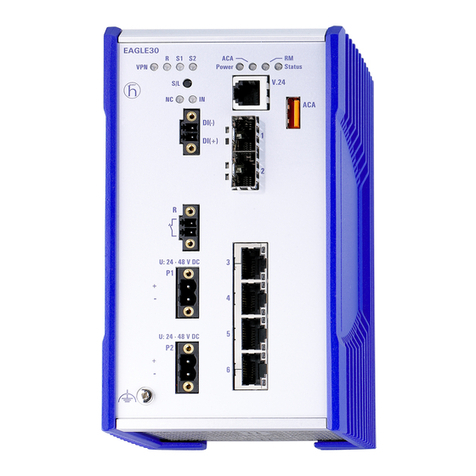
Hirschmann
Hirschmann HiSecOS EAGLE20 Reference manual
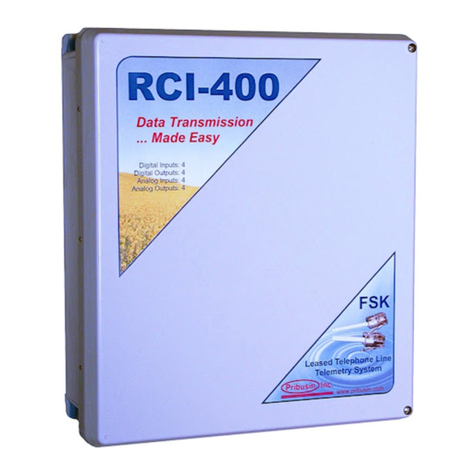
Pribusin
Pribusin RCI-400 Series instruction manual
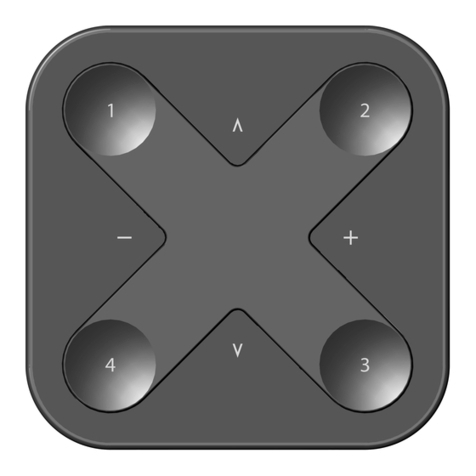
Casambi
Casambi XPRESS-LR Product Technical Specification
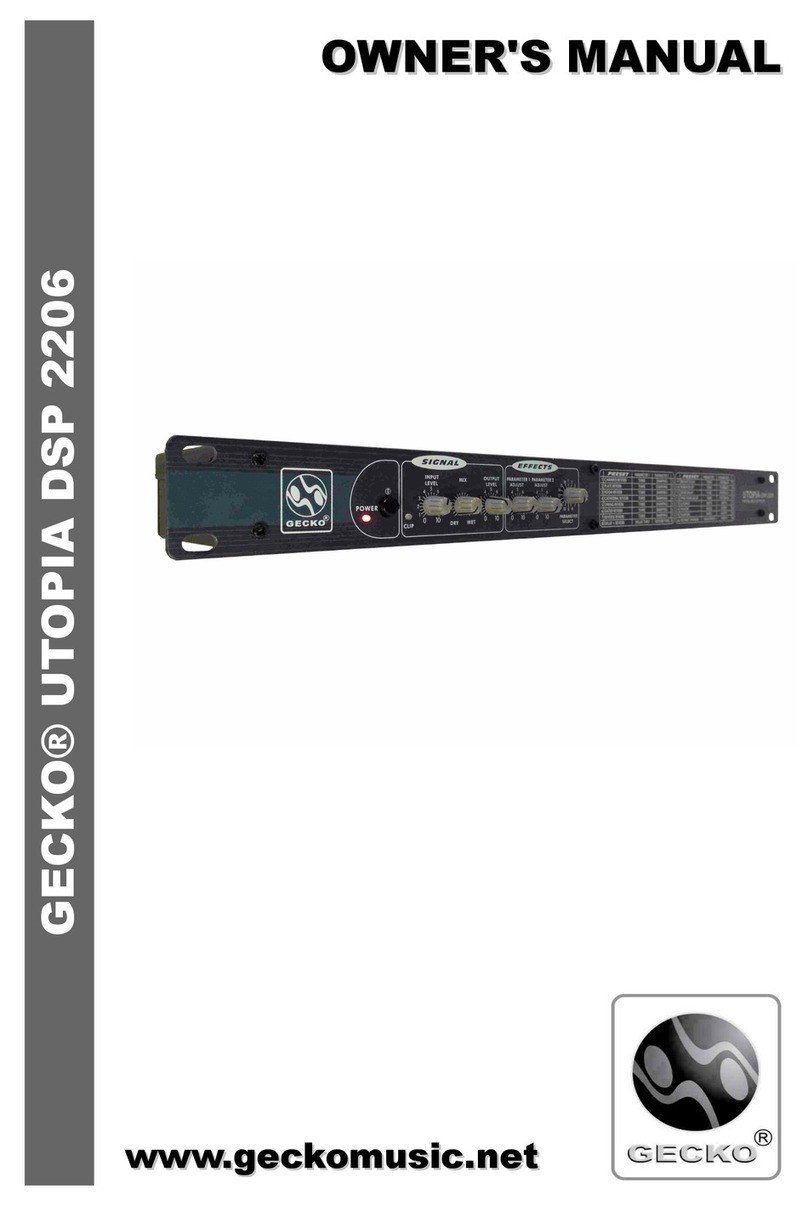
Gecko
Gecko UTOPIA DSP 2206 owner's manual
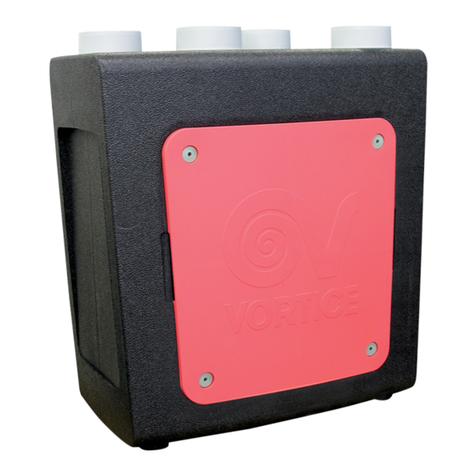
Vortice
Vortice HR 400 Instruction booklet
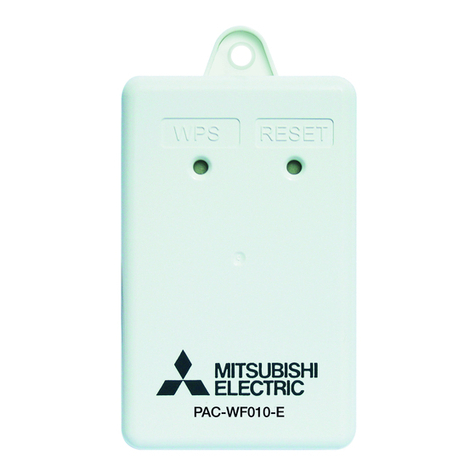
Mitsubishi Electric
Mitsubishi Electric PAC-WF010-E installation manual

